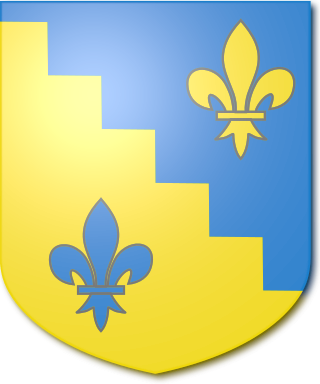Related Research Articles

There have been six baronetcies created for persons with the surname Smyth, two in the Baronetage of England, one in the Baronetage of Great Britain, one in the Baronetage of Ireland and two in the Baronetage of the United Kingdom. One creation is extant as of 2010.
Nineteen baronetcies have been created for persons with the surname Hamilton, eight in the Baronetage of Nova Scotia, one in the Baronetage of England, five in the Baronetage of Ireland, one in the Baronetage of Great Britain and four in the Baronetage of the United Kingdom. As of 2008 two creations are extant, two are dormant, two are either extinct or dormant and twelve extinct.
There have been four baronetcies for persons with the surname Blake, one in the Baronetage of Ireland, two in the Baronetage of Great Britain and one in the Baronetage of the United Kingdom. Two of the creations are extant as of 2010. The Blake Baronetcy, of Menlough in the County of Galway, was created in the Baronetage of Ireland on 10 July 1622 for Valentine Blake, Mayor of Galway in 1611 and 1630 and a member of the Irish House of Commons for County Galway. His grandfather Thomas Blake had preceded him as Mayor. The second Baronet was a member of the Irish Parliament for Galway Borough. The third Baronet represented both County Galway and Galway Borough in Parliament. The sixth Baronet was a member of the Irish House of Commons for County Galway. He was the first Catholic gentlemen of distinction to join William of Orange. The twelfth Baronet represented Galway Borough in the British House of Commons. The fourteenth Baronet was high sheriff of County Galway in 1872. See also the Blake Baronetcy of Twizell Castle below.
Sir William Lowther, 2nd Baronet was an English landowner from Swillington, and a baronet in the Baronetage of Great Britain.
Sir John Abdy, 4th Baronet was a British baronet and Tory politician.
Sir Anthony Thomas Abdy, 5th Baronet, KC was a British barrister and Whig politician.

There have been three baronetcies created for persons with the surname Chapman, one in the Baronetage of Great Britain, one in the Baronetage of Ireland and one in the Baronetage of the United Kingdom. Two of the creations are extinct while one is extant.
Three baronetcies were created for persons with the surname D'Oyly, two in the Baronetage of England and one in the Baronetage of the United Kingdom. One creation is extant as of 2008.
There have been four baronetcies created for persons with the surname Rich, two in the Baronetage of England, one in the Baronetage of Great Britain and one in the Baronetage of the United Kingdom. As of 2008 three of the creations are extinct while one is dormant.
There have been two baronetcies created for persons with the surname Coghill, both in the Baronetage of Great Britain. One creation is extant as of 2008.

The Shee Baronetcy, of Dunmore in the County of Galway, was a title in the Baronetage of Ireland. It was created on 22 January 1794 for George Shee, who subsequently represented Knocktopher in the Irish House of Commons. The title became extinct on the death of the second Baronet in 1870.
William Mayne, 1st Baron Newhaven PC, known as Sir William Mayne, Bt, between 1763 and 1776, was a British merchant and politician who sat in the House of Commons from 1774 to 1790.
Sir Richard Sandford, 3rd Baronet was an English landowner and Whig politician who sat in the English House of Commons between 1695 and 1707, and in the British House of Commons from 1708 to 1723.

Sir Charles Kemys Tynte, 5th Baronet, of Halswell House, near Bridgwater, Somerset and Cefn Mably, Glamorganshire, was a British politician who sat in the House of Commons between 1745 and 1774.
George Augustus Henry Anne Parkyns, 2nd Baron Rancliffe of Bunny Hall was an English landowner and politician from Nottinghamshire. A baron in the peerage of Ireland, he sat in the House of Commons of the United Kingdom for thirteen of the years between 1806 and 1830.
Sir Robert Talbot, 2nd Baronet of Carton was an Irish landowner, soldier, and politician. He sat for County Wicklow in the Irish parliament 1634–1635.
Sir Tristram Dillington, 5th Baronet of Knighton, Isle of Wight was a British Army officer, landowner and Whig politician who sat in the House of Commons between 1707 and 1721.
Sir Robert Pollock, 1st Baronet, of Pollok, was a British Army officer and Scottish politician who sat in the Parliament of Scotland from 1700 to 1707 and in the British House of Commons from 1707 to 1722.

Sir John Turner, 3rd Baronet (1712–1780), of Warham, Norfolk, was a British lawyer and politician who sat in the House of Commons from 1739 to 1774.
Sir John Coghill, 1st Baronet, known before 1775 as John Cramer, was an Anglo-Irish politician.
References
- 1 2 3 4 Cokayne, George Edward (1900). Complete Baronetage (Volume V). Exeter: W. Pollard & co., ltd. pp. 211–212.
- 1 2 Christie, I.R. (1964). "COGHILL (formerly MAYNE), John (d.1785), of Richings Park, Bucks.". In Namier, L.; Brooke, J. (eds.). The History of Parliament: the House of Commons 1754-1790. History of Parliament Online. Retrieved 25 September 2023.
- ↑ John Burke & Bernard Burke, A Genealogical and Heraldic History of the Extinct and Dormant Baronetcies of England, Ireland, and Scotland (W. Clowes, 1844), p.122.